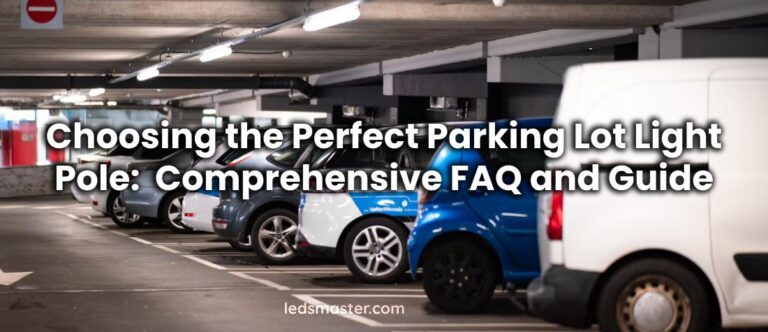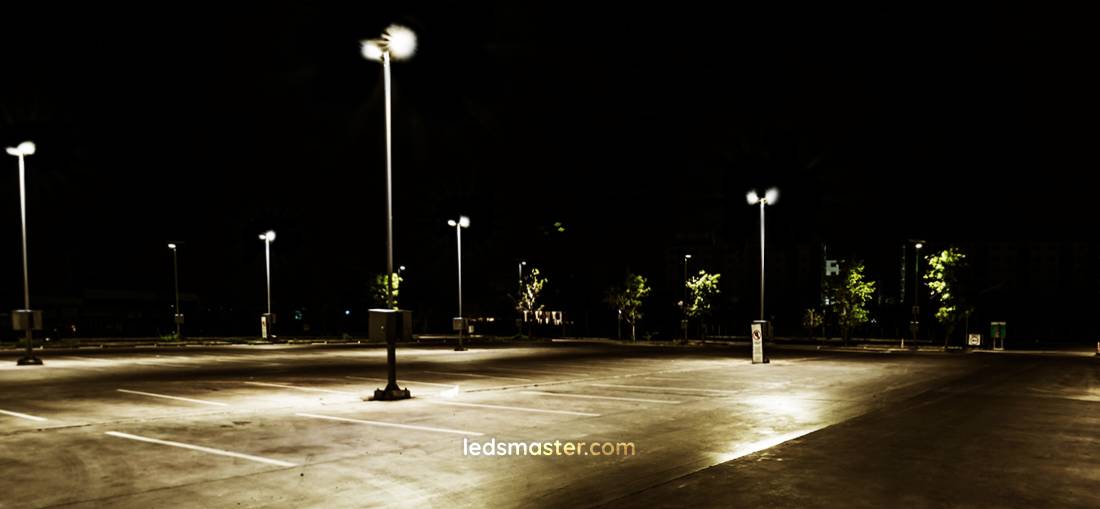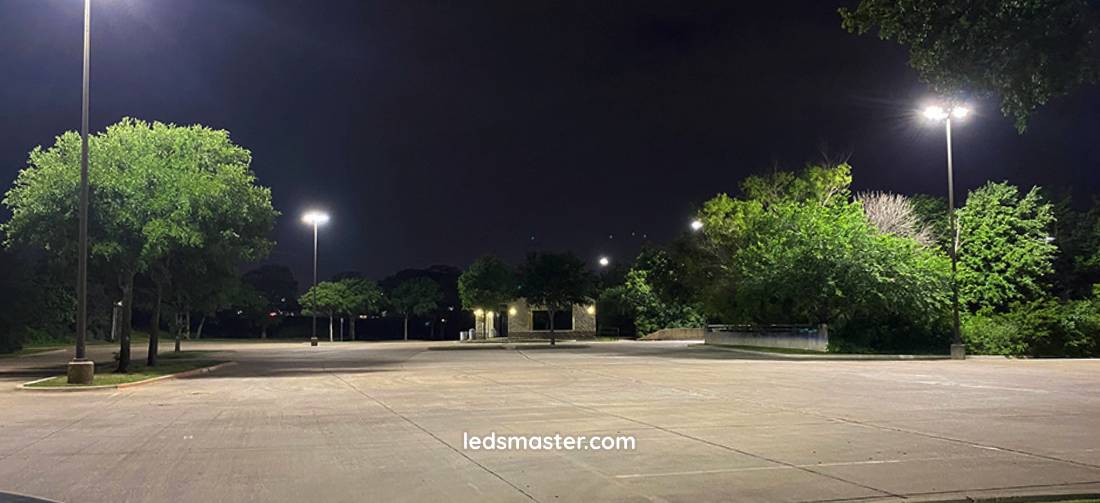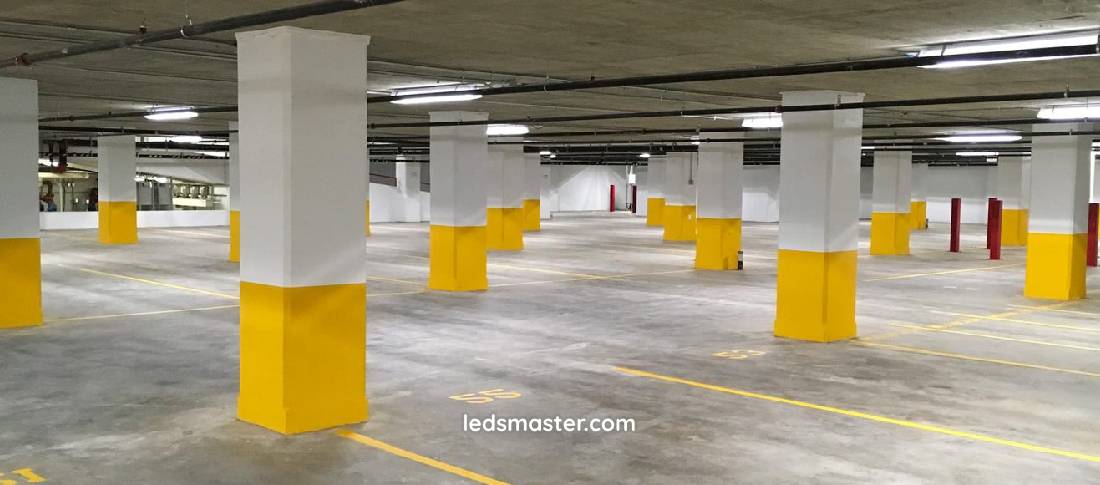
Picture arriving at a parking lot at night. The visibility and comfort you feel depend largely on the lighting around you. Parking lot lighting poles are essential for enhancing safety, guiding drivers and pedestrians, and creating a welcoming atmosphere.
Get your complimentary lighting design today
Parking lot lighting poles are designed to illuminate large spaces effectively, enabling drivers and pedestrians to navigate safely during nighttime. This discussion delves into various aspects of parking lot lighting poles, including their types, materials, technologies, installation considerations, and overall benefits.
Table of Contents
ToggleParking lot lighting poles are available in various materials, each offering unique advantages and drawbacks. Steel poles are a common choice due to their strength and durability. They can withstand harsh weather conditions, making them suitable for outdoor environments. However, steel is susceptible to rust if not properly coated or maintained.
Aluminum poles present a lightweight alternative to steel. They are resistant to corrosion, making them ideal for coastal areas where saltwater exposure is a concern. Although aluminum poles are less sturdy than their steel counterparts, they still provide adequate support for lighting fixtures and are easier to install due to their lighter weight.
Fiberglass poles have gained popularity for their durability and resistance to weather-related wear and tear. They are non-conductive, making them safe options in environments with electrical hazards. Fiberglass poles are also lightweight, which simplifies installation. However, their higher cost compared to steel and aluminum may deter some buyers.
Wooden poles have a traditional appeal and are often used in rural or residential areas. While they blend well with natural surroundings, wood requires regular maintenance to prevent rot and insect damage. These poles may not be suitable for high-traffic commercial parking lots due to their vulnerability.
The height of parking lot lighting poles varies to accommodate different lighting needs and environments. Standard heights typically range from 12 to 20 feet. Shorter poles may be adequate for smaller parking lots, while taller poles provide better illumination for expansive areas. The height of the pole influences the distribution of light, and careful consideration is necessary to ensure adequate coverage without excessive glare.

Parking lot lighting poles come in various designs, from traditional styles to modern aesthetics. Traditional designs often feature ornamental details that enhance the overall appearance of the parking area. These poles can create a welcoming atmosphere, making them suitable for shopping centers or community spaces.
Modern lighting poles tend to prioritize functionality and minimalism. They may have sleek lines and contemporary materials, contributing to a more streamlined look. Decorative styles can blend with architectural features of nearby buildings, adding to the visual appeal of the environment.
The advent of LED lighting has transformed how parking lots are illuminated. LED lights are highly efficient, consuming significantly less energy than traditional lighting options. Their long lifespan, often exceeding 25,000 hours, reduces the frequency of replacements, translating to lower maintenance costs. Moreover, LEDs produce bright, clear light that enhances visibility and safety, making them a popular choice for parking lot lighting.
Environmental considerations have driven many property owners to opt for LED lighting. LEDs have a smaller carbon footprint compared to conventional lighting solutions, contributing to sustainability efforts. The ability to customize color temperatures also allows for tailored lighting solutions that can create different atmospheres in parking areas.
Metal halide lights have been a popular choice for parking lot illumination for many years. Known for their high lumen output, these lights provide excellent visibility and color rendering. This technology is effective in larger lots where bright lighting is necessary for safety.
Despite their advantages, metal halide fixtures have drawbacks. They consume more energy than LEDs and have shorter lifespans, typically around 15,000 hours. Additionally, metal halide lights take longer to warm up, which may result in inconsistent lighting levels during evening hours.
Solar-powered lighting is becoming increasingly prevalent in parking lot applications. These systems harness sunlight to power LED fixtures, offering a sustainable solution that reduces reliance on grid electricity. Solar lights are ideal for remote locations where traditional wiring may be impractical or costly.
While solar-powered lighting presents numerous benefits, there are challenges to consider. The effectiveness of solar lights depends on adequate sunlight exposure throughout the day, which may not be consistent in all geographic locations. Battery performance can also vary based on weather conditions, impacting the reliability of illumination during cloudy or rainy periods.

Advancements in technology have led to the development of smart lighting systems for parking lots. These systems utilize sensors and IoT (Internet of Things) connectivity to monitor and adjust lighting levels based on real-time conditions. For example, lights can automatically dim during low-traffic hours and brighten when vehicles or pedestrians are detected. This not only enhances safety but also improves energy efficiency by reducing power consumption when full illumination is unnecessary.
Many modern parking lot lighting solutions now come equipped with remote monitoring capabilities. This technology allows property managers to oversee lighting performance from a centralized system, receiving alerts for outages or malfunctions. Remote control features enable quick adjustments to lighting settings, ensuring optimal illumination at all times and facilitating timely maintenance responses. These innovations can lead to enhanced operational efficiency and reduced downtime for lighting systems.
Innovative parking lot lighting solutions increasingly integrate with security systems to enhance safety further. By synchronizing lighting with security cameras and alarm systems, property owners can create a comprehensive security network. For example, when motion is detected in a parking area, the lights can automatically increase in brightness, providing better visibility for cameras and deterring potential criminal activity. This integration not only improves safety but also gives patrons peace of mind while using the facility.
Before installing parking lot lighting poles, careful planning and design are essential. A comprehensive layout ensures optimal light distribution and minimizes dark spots. The spacing of poles should be determined based on the desired illumination level, the height of the poles, and the type of lighting fixtures used.
Compliance with local regulations and standards is crucial during the planning phase. Building codes may dictate specific requirements for pole height, spacing, and lighting levels. Engaging with a lighting designer or engineer can help ensure adherence to these guidelines, resulting in a safe and effective lighting solution.
The installation of parking lot lighting poles involves several steps. Site preparation is the first phase, which may include clearing the area and digging holes for pole foundations. The foundation must be sturdy enough to support the pole and withstand environmental factors like wind.
Once the foundations are ready, the poles are mounted securely. This process may involve bolting the poles to the foundation or using concrete to secure them in place. After mounting, the electrical wiring is connected to the lighting fixtures, allowing for proper operation. Testing the system is the final step to ensure that all lights function correctly and provide adequate illumination.
Regular maintenance is essential to keep parking lot lighting poles in optimal condition. Inspections should be conducted periodically to identify any signs of wear, damage, or malfunction. Cleaning the fixtures and poles helps maintain light output and enhances the overall appearance of the parking area.
Replacing burned-out bulbs promptly is necessary to ensure consistent lighting levels. Property managers should also be aware of any corrosion or rust on metal poles, which may require treatment or replacement. Addressing maintenance issues proactively can extend the lifespan of the lighting system and reduce long-term costs.
One of the primary benefits of well-lit parking lots is the reduction of crime. Adequate lighting acts as a deterrent to criminal activity, as perpetrators are less likely to target well-lit areas where they can be easily seen. Studies have shown that improved lighting in parking lots correlates with a decrease in thefts, vandalism, and other criminal behavior.
In addition to deterring crime, good lighting can also foster a sense of safety for patrons. When individuals feel secure in their environment, they are more likely to visit and utilize the facility. Well-lit parking areas contribute to a positive experience, encouraging customer loyalty and repeat business.
Enhanced visibility in parking lots reduces the likelihood of accidents involving vehicles and pedestrians. Well-placed lighting poles illuminate walkways, vehicle paths, and parking spaces, helping drivers and walkers navigate safely. Increased visibility can prevent collisions and minimize the risk of slips and falls.
Parking lot lighting should be designed to eliminate blind spots and ensure that all areas are well-lit. This approach not only enhances safety but also promotes compliance with traffic regulations. Clear sightlines allow drivers to react quickly to potential hazards, creating a safer environment overall.
A well-lit parking area contributes to a better overall user experience. Patrons are more likely to feel comfortable and confident when navigating through well-illuminated spaces. This positive experience can influence their decision to return to the establishment, whether it’s a shopping center, office building, or entertainment venue.
Furthermore, adequate lighting can extend the usability of parking lots into the evening hours. Businesses that prioritize customer experience by ensuring safe and inviting parking areas may attract more visitors, ultimately boosting revenue. The psychological benefits of good lighting should not be overlooked, as they play a role in how customers perceive the location.

In recent years, energy efficiency has become a paramount concern for property managers and owners. With rising energy costs and growing environmental awareness, the push for sustainable lighting solutions has intensified. LEDs have emerged as a popular choice due to their low energy consumption compared to traditional options.
LEDs consume up to 75% less energy than incandescent or metal halide lights. This efficiency translates to reduced operational costs, allowing property owners to allocate funds to other critical areas. Moreover, the longevity of LED fixtures means fewer replacements, further decreasing energy use associated with manufacturing and disposal.
The benefits of LED and solar-powered lighting extend beyond energy savings. Solar lighting systems, in particular, can significantly reduce electricity bills and reliance on the grid. This self-sustaining option is especially appealing for remote locations where extending power lines is impractical.
The environmental impact of adopting energy-efficient lighting solutions is also noteworthy. By reducing energy consumption, property owners can lower their carbon footprint and contribute to broader sustainability initiatives. As consumers increasingly seek environmentally friendly businesses, investing in energy-efficient lighting can enhance a brand’s reputation.
While the initial investment in quality parking lot lighting may seem high, the long-term cost savings are substantial. Energy-efficient technologies such as LEDs and solar options require fewer resources over time, leading to lower operating expenses. The reduced frequency of maintenance and replacement also contributes to significant savings.
In many cases, local governments and utilities offer incentives for adopting energy-efficient lighting solutions. These incentives can offset the initial costs, making it more financially viable for property owners to upgrade their systems. Over time, the return on investment can be realized through lower energy bills and reduced maintenance costs.
Parking lot lighting poles represent more than just functional structures. The selection of materials, heights, designs, and lighting technologies can greatly influence the effectiveness of a lighting system. Through careful planning, installation, and maintenance, property owners can create inviting and secure environments that encourage patronage and promote positive experiences. As energy efficiency becomes increasingly prioritized, adopting modern lighting solutions such as LEDs and solar-powered systems not only supports sustainability but also delivers long-term cost savings. The tangible benefits of well-lit parking areas extend beyond aesthetics, influencing safety, customer satisfaction, and overall operational success.